

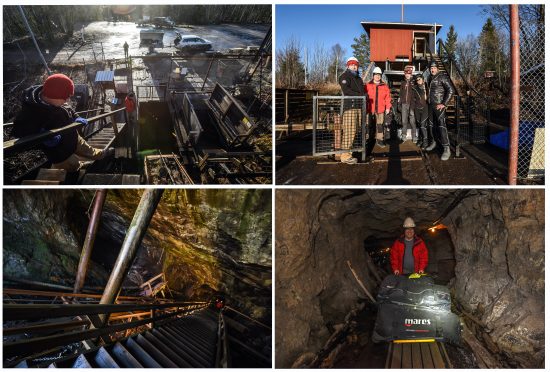
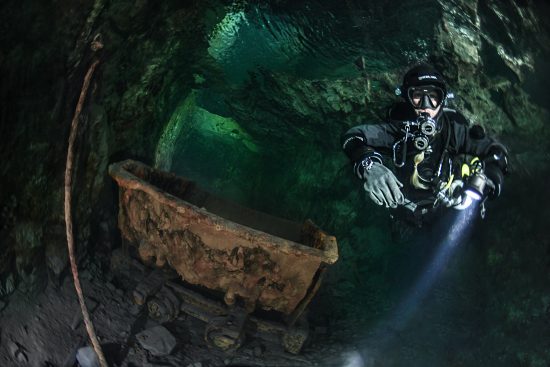
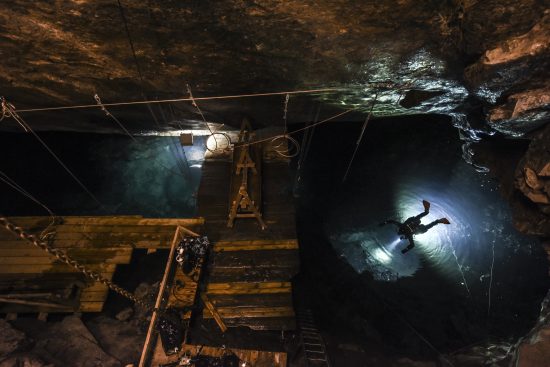
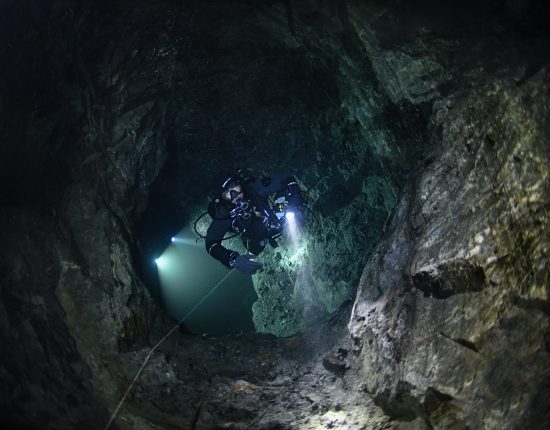
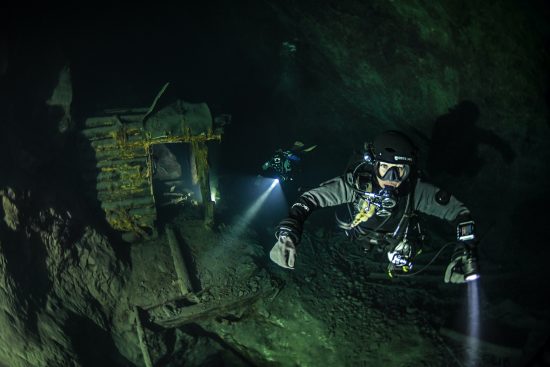
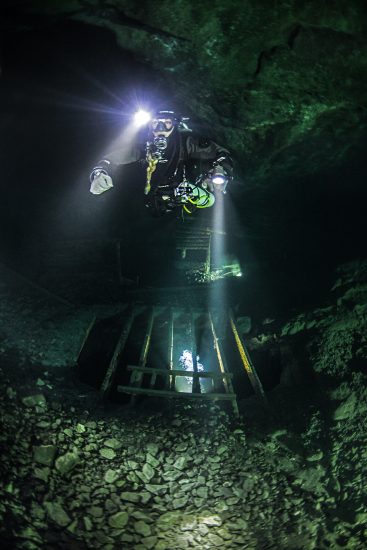
I believe that Jules Verne would not be angry that I borrowed part of his title to begin the story of our adventure to the center of the Earth. Of course, this should be understood figuratively, because we did not travel, but dived. To experience this kind of journey, one has to go to Sweden, a country of steel and conservation.
The Tuna Hastberg mine was our destination. An international team of Mares ambassadors, Ivana OK and Janez Kranjc, with the guidance of Micke Tilja (diving manager of the mines), Lelle Malmstrom (Editor-in-Chief of Sport Dykaren) and the support of Marcyn Pawelczyk (https://divers24.pl/), headed to the north of this Nordic country.
Upon leaving the capital city, we noticed that the cities and towns thinned out. We were surrounded by landscapes of endless lakes and forests. The past winter had been very warm, so we only saw snow and ice every now and then. In the last big town, before arriving at our destination, we were supplied with groceries, because where we were going there were no supermarkets and shops, let alone restaurants. In the beginning, it sounded very promising.
Tuna Hastberg is a village of about fifteen houses. It was created as a settlement for miners who worked in the mine. The mine itself is about 500 years old. It is interesting that none of the miners were killed during the period that the mine was in operation. There were some incidents, but no casualties. Mining of steel ceased in the 1960s then the water began to flood the underground corridors. Due to the configuration of the terrain, it is extremely transparent. Swedish divers started exploring the Tuna Mines just over 10 years ago. This place became famous very quickly all over the world among lovers of diving in vaulted environments, such as caves and mines.
Minimal maximalism
Real divers are non-conformists. Diving is at the forefront of everything. Tuna Hastberg had no hotel or other accommodation, but there was a school. We slept in the school, with some luck in the bunk beds, and with a little less luck among the bags on the mats. One room had been transformed into a dining room, and there was a fully equipped kitchen where you could prepare whatever you liked. There was a sufficient number of bathrooms and toilets, and according to Swedish standards, a small sauna. The rules were the same as in mountain huts – to leave everything as you found it. In other words, clean everything before you leave.
The entrance to the mine shaft can be reached by car. When I peeked under the hood, I saw 400 steps disappearing somewhere in the dark. Fortunately, there is an elevator to transport equipment that goes down 80 meters, where the first level of the mine begins. Tuna Hastberg used to reach down to 600 meters deep where the ore was excavated. The deepest dive that was made at this mine was at a depth of 150 meters. During our stay, the planned depth was 30 meters, which is the maximum depth allowed for standard dives. A deeper venture requires a special permit.
The temperature in the mine is 5°C all year round. The water is a constant 3°C, so use of a drysuit is necessary, as well as other equipment for diving in cold water. The diving zone is one of the best well-kept parts of the mine. There is a compressor room with a Nitrox bank that is the standard for diving in the mine. On the first level, there are benches for the preparation of equipment which is then lowered by a crane to a platform which is at water level. There are also 22°C heating rooms where you can recover after a dive with a hot drink. Tank filling installations are lowered to the platform for entry into the water, so your equipment stays at its lowest point as long as you dive. When you ascend, it is enough to attach the Nitrox hose to the tanks and fill up for the next dive.
In submerged corridors
The Swedes say: "There is no cold weather if you have the right wardrobe". We can absolutely apply this to our experience of diving in a mine. If you have the right equipment, even diving in these conditions can be a supreme pleasure. Not a single dive was shorter than 60 minutes. All dive routes available for normal dives were marked with Ariadne threads. There is a detailed map of the dive zones, and the dive goes with experienced guides. We had the pleasure of having the diving manager at the mine, Micke Tilja, as our guide. He is one of the divers who did the very first explorations of the Tuna Hastberg mine.
Underwater visibility is great, as far as your lamps can see. That's why this is an ideal setting for underwater photographers. There is very little sediment, and if you raise it, it settles very quickly. The mining cottage, the wagons for the transport of ore, the ladders for the transition between digging levels and various unfinished wells, all served as fantastic scenery. However, with a little imagination and photographic skills, even bare rocks can become attractive for photography when you are out of the water.
Recognized possibilities
At the mine, we had the opportunity to meet the “host" Marcyn Wojturski who, together with Angelica Rydelius, takes care of this place.
"We constantly work to improve conditions at the mine. The water entry platform is being expanded, another heating room has been made. And as well as divers, Tuna is a great place for speleologists too, so we have frequent visits from various universities" Marcyn says.
One might think that something like this is only possible in a country like Sweden. Yes, some money is necessary, but perhaps the concerns of society about its resources and a high level of enthusiasm and love for nature are more important. We all have it in us. At the end of the dive day, as you go up those 400 stairs, you realize that getting out of your comfort zone was absolutely worth it!
Text and photo: Janez Kranjc
Model: Ivana OK
All images were captured using Nikon cameras in Subal underwater housing.
 Ivana and Janez
Ivana and Janez 19th May 2020
19th May 2020